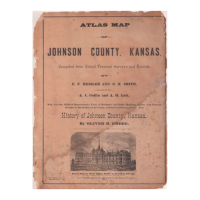Bookmarkable
Atlases Document 150 Years of Change
It’s another grand Throwback Thursday where we encourage you to time travel through Johnson County's history. JoCoHistory is a collaborative presentation of the history from the Johnson County Museum, Johnson County Library and many JoCoHistory partners. Explore historical photographs and documents about the people, places and organizations of Johnson County, Kansas, from the 19th century to the present.
Collection spotlight: Historical Atlases of Johnson County
About this collection: Historical maps and narratives that trace the boundaries of land ownership and the development of townships and cities. Use these atlases to discover how Johnson County has changed over the last 150 years. These high-resolution images allow you to zoom in to view small details.
2022 Elections
Several Johnson County Library locations are polling places in the 2022 Elections due to their central locations within the County. Whether you are a seasoned voter, or voting for the first time, we have all the latest information for you! Read on for the where's, when's and how's of voting!
Overview of important dates for voters in the November 8th General Election:
- Oct. 18, 2022 - Registration Closes - Last day to register
- Oct. 19, 2022 - Advance Voting by Mail Begins
- Oct. 22, 2022 - Advance Voting in Person Begins
- Nov. 1, 2022 - Advance ballot application request deadline - 5 p.m.
- Nov. 7, 2022 – Advance voting in person closes
- Nov. 8, 2022 - General Election - Polls open 7 a.m. - 7 p.m
Questions?
Latest JoCoHistory Blog Explains Johnson County's Poor Farm
OVER the hill to the poor-house I’m trudgin’ my weary way—,
I, a woman of seventy, and only a trifle gray—,
I, who am smart an’ chipper, for all the years I’ve told,
As many another woman that’s only half as old.
Over the hill to the poor-house—I can’t quite make it clear!
Over the hill to the poor-house—it seems so horrid queer!
Many a step I've taken a-toilin’ to and fro,
But this is a sort of journey I never thought to go.
The story from the above 1872 Will Carleton poem “Adversity” was once a common tale for those living with poverty or disability in America. Anyone who could not find self-supporting work – due to age, physical or mental disability, dependent children, or other factors – and who had no family to care for them would find themselves facing the prospect of the poorhouse. Originating in the United Kingdom, poorhouses were institutions designed to employ the poor and disabled in exchange for food, housing and healthcare. As the British Empire spread, so did its ideologies; Colonial America’s larger cities featured poorhouses and, as the Union formed and expanded, so followed poorhouses or – as was more common in the U.S. – poor farms. County governments in each state oversaw poor farms where residents, then referred to as “inmates”, were expected to complete farm labor and housework for room and board.
By the early 20th century, most Kansas counties had a poor farm. Johnson County’s poor farm was built on a 160-acre plot at the corner of what is now 119th Street and Ridgeview Road in Olathe. While its specific origin date is unclear, it opened in the mid-1860s with 8 residents working the farm. With the assistance of a small staff, they grew corn, oats, black sorghum, hay potatoes, cow peas and apples. They raised hogs, cows and chickens. During its tenure, the farm housed an average of 15-40 residents, though times of widespread hardship saw higher numbers.
In 1909, a visiting representative from the Olathe Mirror newspaper described the farm as clean, well-furnished and comfortable. Of its then twelve residents, it was said: “Some of these are too aged to be of any assistance and three of them are blind, so that as a whole, the inmates instead of being a help either on the farm or in the infirmary, must be helped.” This was true for many farms across the country. The circumstances leading people to poor farms often made them unsuitable for the hard labor of farm work. Over time, many county-appointed superintendents found it more financially viable to rent their farmland out, using the proceeds to provide for their residents, rather than rely on them for farm output.
As management for poor farms was largely unregulated, quality of life varied greatly among different counties and states. Some superintendents received salaries while others made only what the farm earnings would allow. Ideologies differed too, on what poor farms were designed for, with some treating them as purely charitable ventures while others sought high profits – leading many residents to experience mental and physical abuse, overwork and unclean and inadequate surroundings. Residents of poor farms sometimes shared one razor, toothbrush and wash basin among themselves. Unsurprisingly, disease spread quickly in these places. To justify such conditions, superintendents would claim they did not want to provide what they saw as luxury items, believing that providing comforts would prevent residents from wanting to leave poor farms – but most never had the ability to leave, regardless of want.
Poor farms were ubiquitous for over a century in the United States, but population and economic changes made the already shaky system untenable in the first half of the 20th century. The 1929 economic crisis that ushered in the Great Depression led to overwhelming need for poor relief. Poor farms lacked funding to care for their already existing residents and were unable to take on further economic burdens. By 1933 almost one-third of all Kansas farmland was tax delinquent, and the country was in crisis. In 1935 Congress created the Social Security Act and, with it, federal financial support for the elderly, disabled, dependent mothers and children, and unemployed. These changes, along with a series of housing reforms, allowed many who would have faced poor farms to live independently. Three years later, nearly a third of all Kansas poor farms had been repurposed or closed entirely.
As methods of social relief changed, so did public opinion. Poor farms were increasingly viewed as inhumane and outdated, and public thought turned toward newer institutions designed to provide for people on an individual level – nursing homes, mental health facilities and schools for deaf and blind students. Many former Kansas poor farms were converted to nursing homes, community centers and hospitals. Operating through the end of World War II, the Johnson County Poor Farm became a senior care facility before the land was repurposed for government use. Gone but not entirely forgotten, the plot where the farm once stood still provides services to the county’s many residents; it now houses the Johnson County Department of Health and Environment, MED-ACT and the K-State Research and Extension Office.
-Sam S., Johnson County Library
This Week at the Library
This week at the Library, you can join us at:
Library OnDemand – Available anytime you like.
Your doorway into live and archived programs. Arts & Culture, Career & Finance, Community Matters, Writers and more!
Online Bilingual Storytime / Hora De Cuentos – Monday, Oct. 24, 10 – 11 a.m.
Tune in to our flexible online Storytime featuring stories, songs, fingerplays and movement activities on Facebook Live. Fun for the whole family! Visit JoCoLibrary on Facebook and be sure to ‘follow’ us to get notifications when we go Live. You do not need a Facebook account to watch our Storytimes. Due to copyright laws, live Storytimes will not be available to watch after they conclude.
Facebook Live Book Party: Winter Book Buzz! – Thursday, Oct. 27, 7 – 8 p.m.
Join librarian Gregg Winsor in a presentation on Facebook Live where he will discuss some of the hottest titles that will be hitting the shelves of the Libraries! Looking for a great pick for your book club? What to know what the next bestseller might be before everyone else does? Or maybe you’re just looking for a good book to read? There will be something in this presentation for everyone. Be sure to join us!
One-on-One DNA & Genetic Genealogy Help – Friday, Oct. 28, 9 a.m. – noon
Visit the Johnson County Genealogical Society at www.jcgsks.org to schedule an appointment. A volunteer will contact you by email to set up an in-person or a Zoom session link for you prior to the scheduled date.
Teen Book Swap Café – Saturday, Oct. 29, 2 – 4 p.m.
Refresh your bookshelf and bring a stack of books, audiobooks, and advanced reader copies of books (ARCS/galleys) to swap with other teen readers at the Central Resource Library! Get to know your community as you grab a snack, chat, and trade new or lightly-used books. This program is trade only, no selling will be allowed. Limit of 10 books per person to trade. Registrants will get a free tote to carry all your new books.
Executive Assistant Brings Rich Background, Skills to her Job
Patti Kangethe is marking her first anniversary as Executive Assistant to the Johnson County Librarian. She still feels surprise and joy at the opportunity to serve the Library’s vital mission.
“This is where I never knew I was meant to be,” she says. “It uses all the things that I love. It supports all the things that I love.”
Kangethe brings an impressive set of experiences and skills to the job, as well as a special perspective. As a child, she struggled to learn to read. That gives her extra empathy for others with literacy challenges, and a real appreciation for the Library world of books, audio books and free access to information and services.
This is her first Library job, but she has been an administrative assistant in many capacities, so she is used to helping her professional colleagues do their jobs well.
That’s the role she fulfilled for Sean Casserley, just retired as Johnson County Librarian, and now for his successor, Tricia Suellentrop. Kangethe also serves as liaison between the staff and Library Board.
She grew up in Rockford, Illinois, where her mother taught art. Kangethe loved art and math, but reading strained her brain. She worked hard at spelling and comprehension to overcome those difficulties.
Eventually she and her mother moved to Kenosha, Wisconsin. For her high school senior year, Kangethe commuted daily by train to the Chicago Academy for the Arts, a fantastic experience. Many of her teachers were Kansas City Art Institute graduates, so that inspired her to attend there as well.
From 2003-2007 she reveled in art, majoring in sculpture. She also gained valuable experience as administrative assistant to the sculpture department chair.
After college, she worked briefly for Stephany Leedy, daughter of her teacher, legendary Art Institute professor and Crossroads Art District founder Jim Leedy. She continues to volunteer and support their gallery, the Leedy Voulkos Art Center.
For 10 years, she was an administrative assistant for the SFS Architecture firm in Kansas City. She got married in 2013 and in 2018 earned a master’s degree from Avila in organizational development, learning a lot about management and strategic planning.
She also has a heart for volunteering, and was a crew leader from 2008-2016 with Kansas City Habitat for Humanity, putting her artistic and building skills to use.
“The best part of that,” she said, “was it wasn’t necessarily about building the best house but giving the best experience to the volunteers while making sure the house was safe.”
She and her husband Tony have two sons, Isaiah, 5, and Ezra, born in April 2020, right after the pandemic shutdown. Fortunately, everyone stayed healthy and it was a nice family time.
The family lives in Olathe, and in 2018, Kangethe became development services coordinator with the Olathe Planning Department. She worked closely with developers and the Planning Commission.
When the Library position came open, Kangethe realized she had the right skill set, and she was hired in September 2021. Working with Casserley and now Suellentrop has been wonderful.
“This organization is so committed to supporting its employees,” she said. “They are so forward thinking and allow people the time to think about things and plan for the future.”
She and her family love visiting the Lenexa branch and she can also flex her artistic muscles at Central’s re-opened MakerSpace.
After a year, she’s thriving and learning to anticipate the Library Board’s needs. “They are so supportive,” she said. “They support the work that our staff does and they want our mission to succeed.”
Quarterly Newsletter of the Johnson County Museum
It’s another grand Throwback Thursday where we encourage you to time travel through Johnson County's history. JoCoHistory is a collaborative presentation of the history from the Johnson County Museum, Johnson County Library and many JoCoHistory partners. Explore historical photographs and documents about the people, places and organizations of Johnson County, Kansas, from the 19th century to the present.
Collection spotlight: Album, the Quarterly Newsletter of the Johnson County Museum
The ALBUM newsletter, a quarterly publication from Johnson County Museum, introduces Johnson County's history through articles and photographs.
eLearning Spotlight: Brainfuse HelpNow
“Ask for help. Not because you are weak. But because you want to remain strong.”
— Les Brown
Brainfuse HelpNow has several ways to get homework help:
- Live tutoring daily 2 - 11 p.m.
- Writing Lab to get feedback within one business day
- SkillSurfer for study resources and test prep
- Send Question to get a response within one business day
- LEAP to create a customized learning plan
Plus several more tools to collaborate and learn using the website or mobile app.
This resource is generously supported by the Louis and Elizabeth Nave Flarsheim Charitable Foundation.
This Week at the Library
This week at the Library, you can join us at:
Library OnDemand – Available anytime you like.
Your doorway into live and archived programs. Arts & Culture, Career & Finance, Community Matters, Writers and more!
Step-by-Step through the FAFSA – Tuesday, Oct. 18, 6:30 – 8 p.m.
The Free Application for Federal Student Aid, or FAFSA, is the federal application necessary to get free and low-cost money for college. Join Jason Anderson, CPA, CFP®, managing member and senior consultant at Gradmetrics, at Central Resource Library, as he walks line-by-line through the FAFSA form and explains the ins-and-outs of the college admissions and financial aid process. Registration is required
Maintain Your Ride – Thursday, Oct. 20, noon – 1:30 p.m.
Get your hands dirty and learn to keep your bike in tip-top shape with this free class from Johnson County Library and BikeWalkKC. Live and in-person at the bicycle fix-it stand in front of Central Resource Library, our instructors will teach you how to keep your bike in good working order with a few basic tools and some practical know-how. You will learn how to clean and lubricate your chain, fix a flat, adjust shifting and braking, and basic bike maintenance skills. We’ll also show you how to use the fix-it stand. This is a hands-on class! Registration is required.
Small Business Administration Funding for Your Business – Thursday, Oct. 20, 6:30 – 7:30 p.m.
Are you looking to start a new business or expand an existing one? Attend this webinar to learn about different types of business funding available in our market. Sheila Forrester, economic development specialist for the U.S. Small Business Administration, will explain how to determine which loan program is the best fit for your business, what a lender looks for when reviewing your loan request, and how to get in touch with an SBA resource partner who can help you along the way.
Friends of the Library Pop-Up Book Sale – Saturday, Oct. 22, 11:30 a.m. – 5 p.m.
Shop gently used books and items at the Friends of the Library headquarters!
20% Friends members discount all day!
Teen Book Swap Cafe – Sunday, Oct. 23, 2 – 4 p.m.
Refresh your bookshelf and bring a stack of books, audiobooks, and advanced reader copies of books (ARCS/galleys) to swap with other teen readers at the Antioch Library! Get to know your community as you grab a snack, chat, and trade new or lightly-used books. This program is trade only, no selling will be allowed. Limit of 10 books per person to trade. Registrants will get a free tote to carry all your new books.
And much more happening this week »
Writers Conference Highlights Craft and Creativity
Johnson County Library’s Writers Conference is back in person this year and staff couldn’t be happier!
After two challenging years hosting the conference online, the Library is delighted to welcome writers back to the newly refreshed Central Resource Library Nov. 17-19. Participants will share ideas and inspiration, meet with authors and other creatives and have a chance to network and learn from each other.
“Part of our purpose statement for the conference is that we build community,” said Helen Hokanson, the reference librarian who spearheads local writers programming. “Just coming back in person, we feel we are getting our mojo back.”
The conference will feature the book Creative Acts for Curious People, with the subtitle “How to Think, Create and Lead in Unconventional Ways.” This collection was curated by Sarah Stein Greenberg of Stanford’s design institute. Attendees will receive a free copy of the book, and Greenberg will attend the Library event.
“This is a book of exercises designed to get you looking at the world in a different way,” Hokanson said. “As writers, that’s something we are always trying to do.”
This year's conference kicked off with “Pre-Game” celebration on Sept. 22, where writers could pick up their free book at Central and register if they hadn't already. Those who couldn't make it to that event can retrieve the book at Central before the conference, while supplies last.
“The Pre-Game is a way for us to get people excited about the conference,” said Joseph Keehn, event producer for Johnson County Library. “It’s kind of a little teaser of getting people together.”
Conference registrants are invited to respond to a writers’ prompt from the book and post it to the JOCO Writes blog. Some of the best entries will be shared at the Nov. 17 kickoff.
This year’s theme is “Art For Impact.” Works by artist Patricia Streeper will be on display at Central. Participants in the writing contests will be asked to respond to her art.
This year’s conference, which is expected to attract about 300 attendees, features 22 presenters including favorite returnees like Jessica Conoley and Polly McCann. Beloved musician and author Jim Cosgrove will present. Other unique voices will include Brendan Kiely, Ann-Marie Oomen, Justin Nogy and Steven Kolbe.
The Library encourages in-person attendance for workshops sharing original writing, yoga and meditation sessions, writing in Strang Park behind Central and just stimulating conversations.
But for those who cannot attend in person, the lectures and panel discussions will be available in Library OnDemand, to view live or later.
Hokanson and her conference committee — Diane Haner, Katt Cooper, Lisa Allen and Jesseca Bear — work hard all year to make this a success.
Keehn said it’s a labor of love for this “small but mighty” committee of very dedicated individuals. "The Writers Conference is a signature event for the Library,” Keehn said.
Creative Services Coordinator Cindy Frazer designs the signage, notebook and other materials for the conference. "I enjoy it immensely,” she said. "We are supporting the local writers and authors in our community, and artists in some cases.”
As always, this is not an event about publishing but about the writing craft: skill-building, learning, and having work edited and critiqued.
"We want to connect writers with readers and writers with other writers,” Hokanson said. "Our goal is to get people in the best place possible to be ready to publish, to be ready to pitch. So we really focus on the front end, the process and the product.”








